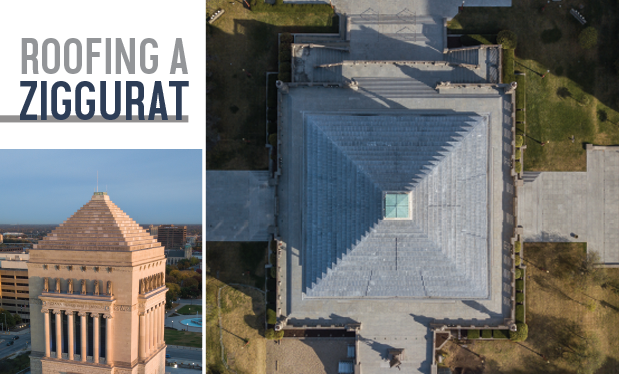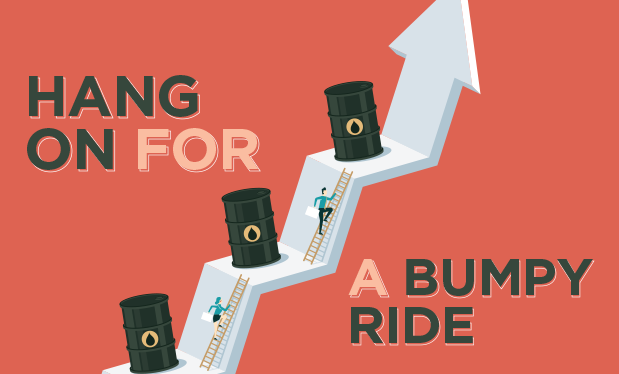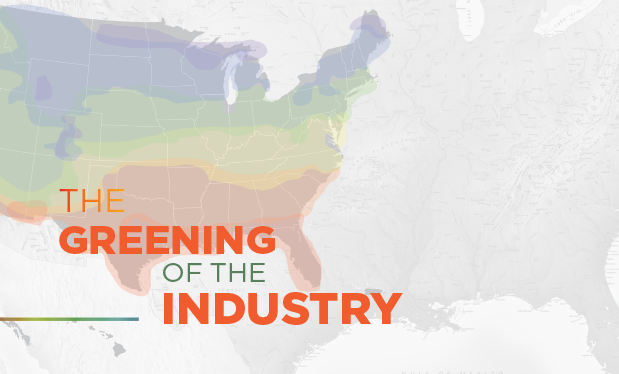Sustainable and environmentally friendly operations have become essential aspects for businesses across the globe, and consumers are expecting their favorite brands and companies to operate sustainably. For the roofing industry, customers are looking for contractors who exemplify these actions through eco-friendly roofing that benefits the environment.
From using metal, clay or recycled asphalt shingles to installing living green roof systems, customers are seeking more opportunities to help the environment and investing in these methods. We have seen this across North America as green roof system installations have increased about 15% since 2013, according to The New York Times. As more people become aware of the reduced carbon footprints of green roofing materials, this trend will continue for residential and commercial roofing.
However, it is important to emphasize though building green and installing eco-friendly roof systems provide numerous benefits to the environment and building occupants, there are some drawbacks that must be considered. Following are some advantages and disadvantages of eco-friendly roofing you can discuss with customers before committing to these types of projects.
Environmental benefits
You can protect and enhance ecosystems and biodiversity in a variety of ways by using sustainable roofing products and green building methods such as the LEED® rating system developed by the U.S. Green Building Council.
The sustainable principles of the LEED system include erosion and sediment controls, soil stabilization and pollution-prevention measures to ensure pollutants are discharged correctly and safely. According to USGBC, structures using the LEED system consume 25% less energy and 11% less water than their nongreen counterparts in addition to diverting more than 80 million tons of waste from landfills.
Eco-friendly roofing options such as metal are 100% recyclable, and these roof systems can accommodate up to 40% recycled steel compared with asphalt shingles. Based on a widely cited September 1999 report by the Vermont Agency of Natural Resources, nearly 11 million tons of asphalt roofing shingle waste are produced in the U.S. each year.
For green roof systems, the Environmental Protection Agency found in a 2018 case study the 700,000 square feet of green roofs installed in Kansas City, Mo., between 1999 and 2000 would help avoid plaguing the external environment of 384 pounds of nitrogen oxide, 734 pounds of sulfur dioxide and 269 tons of carbon dioxide in 2020.
These are just some of the many examples of how sustainable building and roofing can have a profound effect on our environment.
Health benefits
For roofing, the eco-friendly materials used to build a green roof can enhance the air quality of buildings as well as increase thermal and acoustical qualities, resulting in HVAC systems not having to work as hard to maintain desired temperatures. As a result, residents experience a higher level of comfort and health.
Along with benefiting the external environment, occupants of eco-friendly structures realize an improved quality of life—a major factor why many people request green roof systems for their structures.
Economic benefits
The economic benefits green building produces will take some time to outweigh initial costs. However, in the long term, the return on investment will be reflected well on utility bills with significantly reduced energy consumption. Eco-friendly structures under the LEED system use around 20% to 30% less energy and water than standard spaces, according to USGBC, with some reporting up to 60% in energy savings. Additionally, building owners who build green under the LEED system have seen a 10% increase in asset value while also decreasing operational costs by almost 20%.
According to a cost-benefit analysis conducted by the U.S. General Services Administration published in June, those who install green roof systems on their structures can see more than a 200% return on investment with about 50 years of endurance combined with savings on energy, water, heating and cooling, repairment fees and more. More specifically, according to EPA, green roofs produce $14 more in benefits per square foot than conventional roofs, and cool roofs produce about $2 more per square foot.
For homeowners who install eco-friendly roof systems, they will see the value of their homes greatly increase over time, which can be vital in the housing market we’re currently experiencing and a significant benefit for your customers.
Most green building materials also are higher quality, resulting in more durability and providing a more sustainable design, construction and operational practice. This results in a win-win situation for homeowners who may be looking to sell their homes along with ones looking to enhance their homes for the long haul.
Costs
The benefits of eco-friendly roofing may sound great to your customers. However, there are some disadvantages you need to discuss with them.
With most contracting projects, we look for the way to spend the least amount of money while still aiming to get the best possible quality. The costs involved with eco-friendly roofing can deter contractors and customers from recognizing the long-term benefits.
The initial cost of going eco-friendly with a roof system typically is the biggest disadvantage. For those who opt for green roof systems, the initial costs are higher than conventional roof systems. According to GSA, the costs range from $10.30 to $12.50 per square foot more for multicourse extensive green roofs or $16.20 to $19.70 per square foot for semi-intensive green roofs. Green roof systems also require more frequent and extensive maintenance compared with traditional roof systems, resulting in annual maintenance costs between 21 cents to 30 cents per square foot more than conventional roofing materials.
Even if your client simply wants an eco-friendly material (clay, metal, slate, recycled shingles, etc.), the costs of these materials are more than conventional roofing materials. If you and your customers are looking to operate and complete jobs on a low budget, the costs of eco-friendly materials may be difficult to overcome.
Material availability
Something that factors into the high initial cost of eco-friendly roof systems is the lack of availability of materials needed to build a green roof system and structure. Sustainable roofing materials can be difficult to obtain or, in some cases, unavailable for contractors for various reasons.
As with any scarce item, costs for these specific items are comparably higher than standard building materials. For example, slate roofing material takes a lot of time to mine, process and transport, costing more per square foot, furthering the cost dilemma.
Geography can play a role, as well. Metropolitan and urban roofing projects have access to materials while those in rural communities may have a tougher time locating these items, causing project delays.
The market for green and eco-friendly building materials continues to become more competitive as a result of growing requests from homeowners, building owners and property owners. This means the necessary materials eventually will become widely available, ultimately decreasing their costs in the future.
Similar to the initial cost dilemma, if you and your clients can withstand the hurdles associated with obtaining sustainable roofing resources, the long-term goal of a quality and efficient sustainable roof system will be attained.
Time
Sustainable roofing can have a longer timeline because of the nature of the job, which is important to stress to your customers up front so they know the potential for project delays. The complexity of eco-friendly roofing projects and material scarcity are the usual culprits in any sort of delays.
What’s more, these also can cost your clients (and you) more money. If there is worry about the initial costs at the beginning of this type of project, any added costs for potential delays won’t be welcome.
It’s an investment
It’s imperative for contractors who install eco-friendly roof systems and the customers who ask for them to discuss and contemplate the pros and cons of this method of roofing. Although the short-term optics may not seem worthwhile, the long-term advantages sustainable building brings can make it a profitable investment for those looking to help the environment while also enhancing the quality of their homes or buildings.
JOSH WHITE is president of Hoosier Contractors LLC, Indianapolis.



